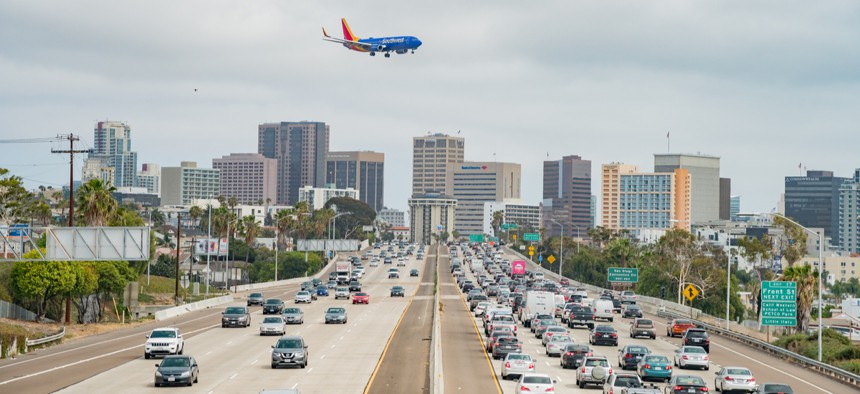Surveying the Public in a City Being Used as Federal Drone Testing Site

A plane prepares to land at San Diego International Airport near downtown San Diego. Shutterstock
Taking the temperature of San Diego residents before UberEats starts deploying delivery drones to the skies.
In May, Federal Aviation Administration selected San Diego as one of 10 sites across the nation that will conduct advanced testing of unmanned aerial systems technology over two years. The work underway in San Diego and the other test locations will help inform federal policymakers who regulate the drones and ensure safety when they’re introduced and integrated into local airspace.
It’s a true cross-sector collaborative effort in San Diego, with the neighboring city of Chula Vista, the Port of San Diego and the San Diego Regional Economic Development Corporation among the governments and organizations supporting the work. This includes testing drone technology that will help local firefighters gather vital intelligence on wildfires and medical professionals at UC San Diego using drones to transport blood and medical supplies more quickly.
San Francisco-based Uber, meanwhile, is planning to use San Diego’s skies to test UberEats food delivery using drones, with hopes of making their vehicles ready for commercial service by 2021.
It comes at a time when more advancements have been made in unmanned aerial systems, including a recent successful drone test by the University of Maryland Department of Aerospace Engineering to safely deliver live human organs.
But what does the public think of the ongoing advancements in aerial drone technology and a future that appears destined to include more crowded skies over cities?
The city recently launched a 25-question online survey to take the temperature of what the public knows about aerial drone technology and attitudes about their various uses.
One question is: “Select the word that best describes your feelings towards drone usage?” The choices are “excited,” “very excited,” “scared,” “indifferent,” “nervous,” “angry” or “interested.”
Others include: “Would you be in support of law enforcement using drones in your community?”; “What is your top concern about drone technology?”; and “How comfortable are you with drones flying near you or over your home in transit to some other location?”
“This survey will provide vital information for the program to gauge and understand the interest and concerns of residents in our area,” Mark Cafferty, chief executive of the San Diego Regional Economic Development Corporation, told The San Diego Union Tribune. “The data collected will be invaluable in advancing the program as we look to grow the innovation economy and create jobs.”
As part of the FAA testing initiative, the San Diego Fire Department in August began using drones outfitted with cameras and heat sensors that will give firefighters better intelligence about wildfires to help make decisions about how to fight a blaze and bring it under control.
While there are already many fire departments utilizing drone technology, the San Diego Fire Department is testing a telepresence drone platform from Redwood City, California-based Cape, where trained drone pilots will control the devices once they’re launched by first responders on the ground, as VentureBeat reported at the time.
Other state and local entities included in the FAA’s drone-testing program are Reno, Nevada; the University of Alaska-Fairbanks; the Kansas Department of Transportation; the North Dakota Department of Transportation; the North Carolina Department of Transportation; Choctaw Nation of Oklahoma; the Innovation and Entrepreneurship Investment Authority in Herndon, Va.; the Memphis-Shelby County Airport Authority; and the Lee County Mosquito Control District in southwest Florida.
PREVIOUSLY on Route Fifty:
Michael Grass is Executive Editor of Route Fifty and is based in Seattle.
NEXT STORY: DARPA eyes 'less-explored avenues' of blockchain






